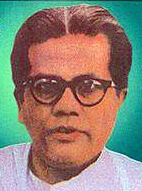A True Son of Assam
Jyoti Prasad Agarwala, the first filmmaker of Assam, had his roots in the Marwari community of Rajasthan, yet his heart and soul belonged to Assam. His contributions to Assamese art, literature, and cinema were so profound that few names in Assam’s history can compare to his influence. Known as “Rupkonwar,” he played a crucial role in shaping Assamese Culture. His forefather arrived in Assam in 1811, but it was Jyoti Prasad who became a cultural beacon for the state. In honor of his remarkable contributions, his death anniversary on January 17 is observed as “Silpi Divas” across Assam.
Early Life and Education
Born on June 17, 1903, at Tamulbari Tea Estate in Dibrugarh, Jyoti Prasad was the son of Paramananda Agarwala and Kiranmayee Agarwala. He began his schooling at Tezpur Government High School and completed his matriculation in 1921. Even as a student, he actively participated in India’s freedom movement. He pursued higher studies at National College, Calcutta, where he completed his I.A. In 1926, he moved to Edinburgh University in Britain to study economics. He later enrolled in an M.A. program but left it midway to go to Germany. There, he spent seven months at the prestigious UFA Studio, gaining hands-on experience in filmmaking before returning to Assam in 1930.
His Role in India’s Freedom Struggle
Jyoti Prasad was deeply committed to India’s independence. His patriotic spirit led to his imprisonment for 15 months and a fine of ₹500 for his participation in the freedom movement. His dedication to the cause never wavered, and he continued using his artistic talents to inspire people.
Pioneer of Assamese Cinema
Jyoti Prasad began writing at the young age of 14. Alongside ‘Kalaguru’ Bishnu Prasad Rabha, he co-wrote the famous plays “Sonit-Konwari” and “Joymoti.” His passion for storytelling led him to establish the Chitraban Studio at Bholaguri Tea Estate, Tezpur, in 1934. In 1935, he directed and produced Assam’s first-ever film, “Joymoti,” marking the dawn of Assamese cinema. Later, in 1937, he set up a cinema hall named “Junaki” in Tezpur. His second film, “Indramalati,” was released in 1939, further cementing his legacy as a pioneer of Assamese filmmaking. His contributions extended to journalism, as he revived the Assamese newspaper “Asomiya” in 1944 after it had been non-operational for seven months.
A Musical and Literary Genius
Apart from being a filmmaker, Jyoti Prasad was an extraordinary poet and songwriter. He composed over 300 songs, most of which he set to music himself. This vast collection, known as “Jyoti Sangeet,” became a distinct musical genre in Assam. His literary prowess also extended to children’s stories and plays, with notable works including “Rupalim,” “Karengar Ligiri,” and “Lobhita.”
Personal Life and Legacy
In 1936, he married Devajani Bhuyan, who remained a pillar of support throughout his life. Unfortunately, he was diagnosed with cancer and passed away at the young age of 48 on January 17, 1951. His death was a great loss to Assamese culture, but his legacy lives on.
A Lasting Tribute
In 1961, the government proposed the establishment of a public sector film studio in his memory, the first of its kind in India. This studio, named “Jyoti Chitrabon Studio,” was set up on the outskirts of Guwahati, ensuring that his contributions to Assamese cinema and culture would never be forgotten.
FAQ’s:
Q 1. Who was Jyoti Prasad Agarwala and why is he important?
Jyoti Prasad Agarwala was a filmmaker, writer, poet, and musician from Assam. He is known as the first filmmaker of Assam and is often called “Rupkonwar” for his immense contribution to Assamese culture. His works in literature, cinema, and music played a key role in shaping modern Assamese identity.
Q 2. When and where was Jyoti Prasad Agarwala born?
He was born on June 17, 1903, in Tamulbari Tea Estate, Dibrugarh, Assam. His family had roots in Rajasthan, but he was deeply connected to Assamese culture and identity.
Q 3. What was Jyoti Prasad Agarwala’s contribution to Assamese cinema?
He created Assam’s first-ever film, “Joymoti,” in 1935, which was based on historical events. He also established Chitraban Studio in Tezpur, marking the beginning of the Assamese film industry. Later, he made his second film, “Indramalati,” in 1939.
Q 4. Why is Jyoti Prasad Agarwala called “Rupkonwar”?
He is called “Rupkonwar” because of his remarkable contributions to Assamese arts and culture. His work in poetry, music, cinema, and drama brought a new wave of creativity, making him a legendary figure in Assam’s history.
Q 5. What role did Jyoti Prasad Agarwala play in India’s freedom movement?
He actively participated in India’s independence struggle and was imprisoned for 15 months for his involvement. He contributed to the movement through his writings and patriotic songs, which inspired people to fight for freedom.
Q 6. What is “Silpi Divas” and why is it celebrated?
“Silpi Divas” is observed on January 17 every year in Assam to honor Jyoti Prasad Agarwala’s contributions to Assamese culture. It marks his death anniversary and celebrates his work in literature, music, and cinema.
Q 7. What is Jyoti Sangeet?
Jyoti Sangeet is a collection of over 300 songs written and composed by Jyoti Prasad Agarwala. These songs are rich in poetry and melody, and they continue to be popular in Assamese music.
Q 8. Which are some of the famous literary works of Jyoti Prasad Agarwala?
He wrote several plays, including “Rupalim,” “Karengar Ligiri,” and “Lobhita.” His contributions also include short stories, poems, and children’s literature, making him a versatile writer.
Q 9. What was the significance of the newspaper “Asomiya” in Jyoti Prasad Agarwala’s career?
“Asomiya” was a newspaper that had stopped publishing, but Jyoti Prasad Agarwala took the initiative to revive it in 1944. His efforts helped keep Assamese journalism alive during that time.
Q 10. What is Jyoti Chitraban Studio and why was it established?
Jyoti Chitraban Studio was set up in Guwahati in 1961 in memory of Jyoti Prasad Agarwala. It was India’s first public sector film studio and played a major role in the growth of Assamese cinema.












